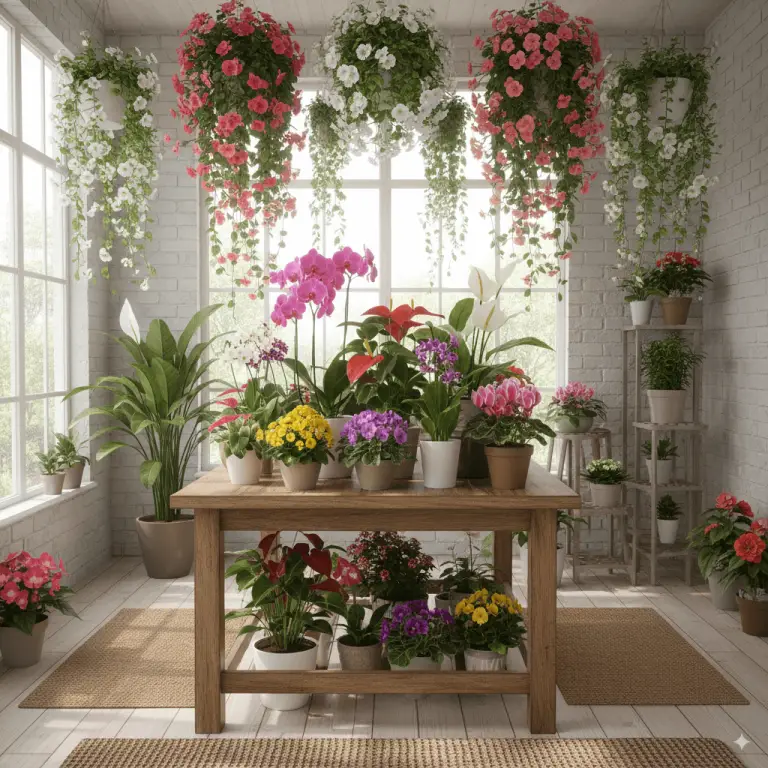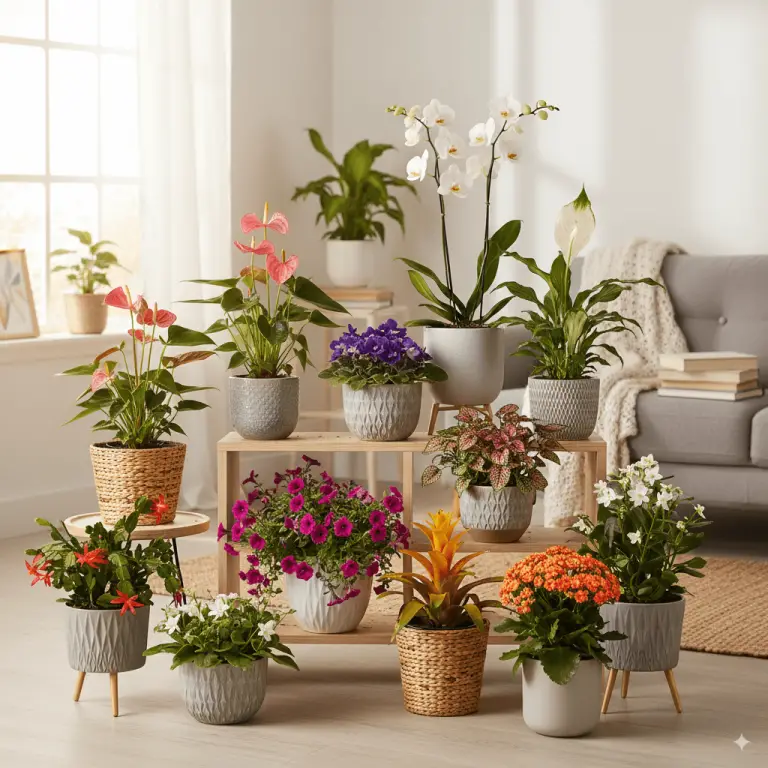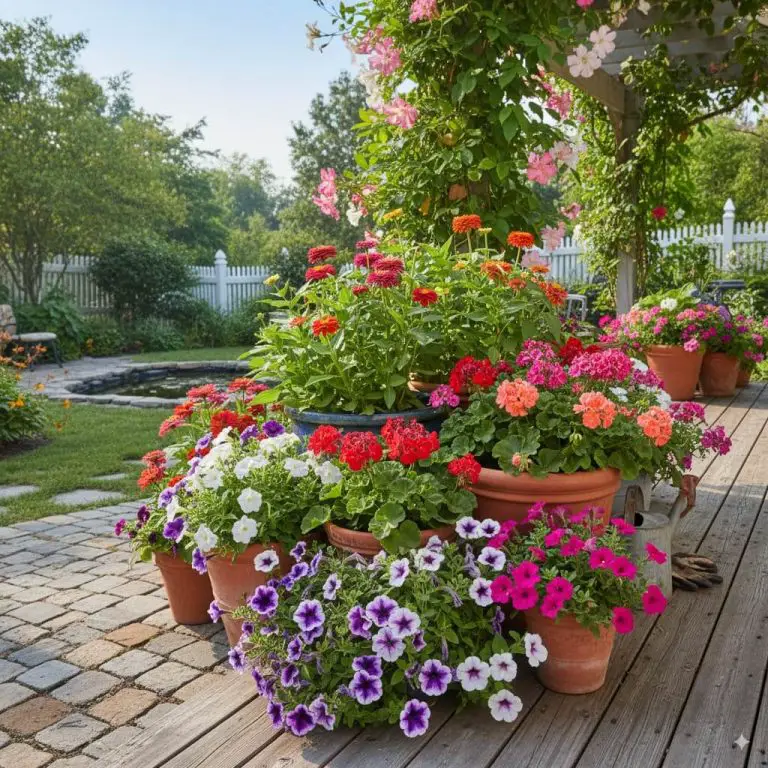Tall Pink Flowering Plants – Create Stunning Height And Drama In Your
Have you ever looked at your garden and felt like something was… missing? You have beautiful colors and lovely textures, but the overall picture feels a little flat. It’s a common feeling for many gardeners, but don’t worry, the solution is simpler and more beautiful than you might think.
I promise that by adding vertical structure, you can completely transform your space from a simple flower bed into a lush, three-dimensional paradise. This comprehensive guide will show you exactly how to use tall pink flowering plants to add that missing “wow” factor. It’s easier than you think!
In this article, we’ll explore my favorite show-stopping varieties, walk you through a complete planting and care guide, and even tackle some common problems. Let’s get ready to elevate your garden to new heights!
What's On the Page
- 1 Why Every Garden Needs Tall Pink Flowering Plants
- 2 Our Top Picks: The Best Tall Pink Flowering Plants for Your Garden
- 3 Your Complete Tall Pink Flowering Plants Guide: From Planting to Perfection
- 4 The Ultimate Tall Pink Flowering Plants Care Guide
- 5 Troubleshooting: Common Problems with Tall Pink Flowering Plants
- 6 Sustainable and Eco-Friendly Tall Pink Flowering Plants Tips
- 7 Frequently Asked Questions About Tall Pink Flowering Plants
- 8 Go Forth and Grow Vertical!
Why Every Garden Needs Tall Pink Flowering Plants
Adding height to your garden isn’t just about filling space; it’s a design secret that professional landscapers use to create dynamic, captivating scenes. The benefits of tall pink flowering plants go far beyond their stunning color.
First, they create a sense of depth and structure. By placing taller plants at the back of a border, you create a beautiful backdrop that makes smaller plants in front pop. This layering technique is one of the easiest ways to make your garden look more professional and thoughtfully designed.

🌿 The Companion Planting & Gardening Book (eBook)
Bigger harvests, fewer pests — natural pairings & simple layouts. $6.99
Get – $6.99
🪴 The Pest-Free Indoor Garden (eBook)
DIY sprays & soil tips for bug-free houseplants. $4.89
Get – $4.99They also act as “thrillers” in container arrangements and garden beds, drawing the eye upward and creating a focal point. A spire of pink foxglove or a stand of hollyhocks can become the star of the show. Plus, many of these plants are magnets for pollinators like bees, butterflies, and hummingbirds, turning your garden into a lively, buzzing ecosystem.
Our Top Picks: The Best Tall Pink Flowering Plants for Your Garden
Ready for some inspiration? Here are some of my all-time favorite tall pink flowering plants, perfect for a range of garden styles and skill levels. I’ve grown every one of these in my own garden, and they never disappoint.
Hollyhock (Alcea rosea)
Nothing says “cottage garden” quite like a towering stalk of hollyhocks. Their large, romantic blooms come in shades from pale blush to deep magenta. They are biennials, meaning they typically grow foliage the first year and flower the second, but they self-seed readily, so you’ll have them for years to come.
- Height: 5-8 feet
- Sun: Full sun
- Pro Tip: Plant them against a fence or wall to provide some natural support against the wind.
Foxglove (Digitalis purpurea)
Elegant and whimsical, foxgloves add a touch of woodland magic. Their tall, bell-shaped flower spires are simply breathtaking. While many varieties are biennial, some newer cultivars are true perennials. Be aware that all parts of the foxglove plant are toxic if ingested, so plant with care around pets and small children.
- Height: 3-5 feet
- Sun: Part shade to full sun
- Pro Tip: They look stunning planted in drifts of three or five for a more natural, impactful look.
Lupine (Lupinus)
Lupines are absolute showstoppers with their dense, vibrant spires of pea-like flowers. They create an incredible vertical accent in early summer. They fix nitrogen in the soil, which is a fantastic bonus for the plants around them. Don’t worry—these flowers are perfect for beginners!
- Height: 3-4 feet
- Sun: Full sun
- Pro Tip: Lupines have a long taproot and don’t like to be moved, so choose their permanent home carefully.
Joe Pye Weed (Eutrochium purpureum)
If you want to attract every butterfly in the neighborhood, plant Joe Pye Weed. This native powerhouse produces huge, fluffy clusters of mauve-pink flowers in late summer. It’s incredibly low-maintenance and a cornerstone of eco-friendly tall pink flowering plants practices.
- Height: 5-7 feet
- Sun: Full sun to part shade
- Pro Tip: It prefers moist soil, making it perfect for rain gardens or areas with poor drainage.
Cleome (Spider Flower)
For a unique and airy texture, you can’t beat Cleome. Its spidery, delicate flower clusters sit atop tall stems and bloom all summer long until the first frost. They are fast-growing annuals that make a huge impact in a single season.
- Height: 3-5 feet
- Sun: Full sun
- Pro Tip: Some older varieties can be a bit sticky and have a strong scent, but newer cultivars have bred these traits out.
Your Complete Tall Pink Flowering Plants Guide: From Planting to Perfection
Knowing how to tall pink flowering plants should be planted and cared for is the key to a successful display. This simple guide breaks down the essential steps to get you started on the right foot.
Choosing the Right Location
Most tall bloomers are sun-lovers. Look for a spot that receives at least 6-8 hours of direct sunlight per day. Also, consider wind protection. A location against a wall, fence, or a hedge can prevent tall, delicate stems from snapping on a blustery day.
Soil Preparation: The Foundation of Success
Healthy soil means healthy plants. Before planting, amend your garden bed with a few inches of well-rotted compost or manure. This improves drainage, adds vital nutrients, and gives your plants the best possible start. Most of these flowers prefer well-draining soil to avoid root rot.
Planting Your Flowers: A Step-by-Step Method
This is one of the most important tall pink flowering plants best practices. Giving them enough space is crucial!
- Dig a hole that is twice as wide and just as deep as the plant’s root ball.
- Gently remove the plant from its container and loosen any tightly bound roots with your fingers.
- Place the plant in the hole, ensuring the top of the root ball is level with the surrounding soil.
- Backfill the hole with the amended soil, gently tamping it down to remove air pockets.
- Water thoroughly at the base of the plant to help it settle in. A good, deep soak is better than a light sprinkle.
The Ultimate Tall Pink Flowering Plants Care Guide
Once your beauties are in the ground, a little ongoing care will ensure they thrive and produce a spectacular show. This tall pink flowering plants care guide covers the essentials.
Watering Wisely
Tall plants, especially during their flowering period, can be thirsty. Water them deeply once or twice a week, especially during dry spells. Always aim to water the soil at the base of the plant, not the leaves, to help prevent fungal diseases like powdery mildew.
Feeding for Fabulous Blooms
A little food goes a long way. I like to feed my perennials with a balanced, slow-release granular fertilizer in early spring as new growth appears. For heavy-blooming annuals like Cleome, a liquid bloom-booster fertilizer every 3-4 weeks during the growing season can work wonders.
Staking and Support: Preventing the Flop
There’s nothing more disappointing than finding your beautiful hollyhocks flopped over after a heavy rain. The secret is to provide support before they need it. Place stakes, cages, or bamboo canes around the plants when they are about one-third of their final height. The foliage will quickly grow to hide the supports.
Troubleshooting: Common Problems with Tall Pink Flowering Plants
Even the most experienced gardeners run into issues. Here’s how to handle some common problems with tall pink flowering plants before they get out of hand.
Pest Patrol: What to Look For
Aphids are a common pest that can cluster on new growth. A strong spray of water from the hose can often dislodge them. For more persistent infestations, insecticidal soap is a great organic option. Slugs and snails can also be an issue, especially for young lupines. Diatomaceous earth sprinkled around the base of the plant can create an effective barrier.
Disease Dilemmas (Like Powdery Mildew)
Powdery mildew is a white, dusty-looking fungus that often appears on hollyhock and Joe Pye Weed leaves in humid weather. The best defense is good air circulation. Don’t overcrowd your plants! If you see it, remove the affected leaves and consider a fungicide spray if the problem is severe.
Why Aren’t My Plants Blooming?
This is a frustrating one! The most common culprits are not enough sun or too much nitrogen fertilizer. Excess nitrogen encourages lush, green foliage at the expense of flowers. Ensure your plants are getting enough light and use a fertilizer that is balanced or higher in phosphorus (the middle number, “P,” in N-P-K).
Sustainable and Eco-Friendly Tall Pink Flowering Plants Tips
Creating a beautiful garden can and should go hand-in-hand with supporting our local ecosystem. Embracing sustainable tall pink flowering plants practices is easy and incredibly rewarding.
Choose native varieties like Joe Pye Weed whenever possible. Native plants are adapted to your local climate and provide essential food and habitat for local pollinators. Reduce your water usage by applying a 2-3 inch layer of organic mulch (like shredded bark or leaf mold) around your plants. This helps retain soil moisture, suppresses weeds, and breaks down to enrich the soil over time.
Finally, avoid synthetic pesticides. By nurturing a healthy garden with rich soil, you encourage strong plants that are naturally more resistant to pests and diseases. This is the core of an eco-friendly tall pink flowering plants strategy.
Frequently Asked Questions About Tall Pink Flowering Plants
What are the easiest tall pink flowers for beginners?
For beginners, I highly recommend Cleome (Spider Flower) and Joe Pye Weed. Cleome is a fast-growing annual that gives you a huge reward in one season, and Joe Pye Weed is an incredibly hardy and low-maintenance native perennial that comes back bigger and better every year.
How do I keep my tall plants from falling over?
The key is proactive support! Use stakes, peony rings, or bamboo canes early in the season, well before the plants are tall and heavy with blooms. This allows the plant to grow into and through the support, making it nearly invisible and much more effective.
Can I grow tall pink flowering plants in containers?
Absolutely! Just make sure you choose a large, heavy pot (to prevent it from tipping over) with excellent drainage holes. Varieties like dwarf Lupines or a single, dramatic Foxglove can look stunning in a container. You will need to be more diligent with watering and feeding, as containers dry out much faster.
Go Forth and Grow Vertical!
You now have all the tools and inspiration you need to add breathtaking height and color to your garden. From selecting the perfect hollyhock to staking your lupines, you’re ready to create a garden that’s not just beautiful, but dynamic and full of life.
Remember, gardening is a journey of learning and joy. Don’t be afraid to experiment, move things around, and see what works best in your unique space. The simple act of planting these stunning tall pink flowering plants will reward you with seasons of beauty.
Happy gardening!
- How To Cut Back Cucumber Plants For A Bigger, Healthier Harvest - November 7, 2025
- When To Cut Back Cucumber Plants – Your Ultimate Guide For A Bountiful - November 7, 2025
- Cucumber Plant Diseases Treatment – Your Guide To Spotting And - November 7, 2025



